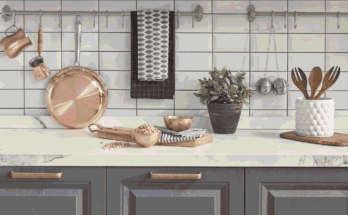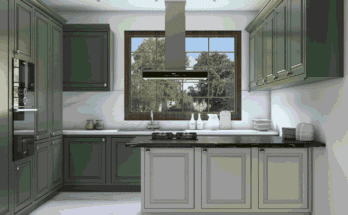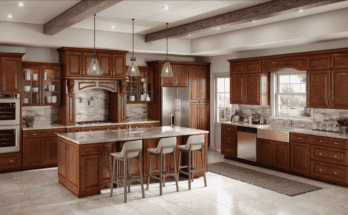1. Introduction
More than an addition to your cooking area, a kitchen island is a versatile and central focal point with the potential to revolutionize your kitchen’s design. Since the concept of open space has become increasingly famous in modern designs, the kitchen island is at the centre of the living area. It operates perfectly between style and functionality by providing the homeowner with a solution that meets the requirements of cooking, dining, and socializing.
This article will uncover all the information necessary before placing a kitchen island, including types of kitchen islands, tips for kitchen island design, and more. Whether you are redesigning the kitchen or designing a new one, this guide will help your island become the ideal addition to your home.
2. Advantages of having a kitchen island.
Increased Counter Space
Perhaps the most obvious advantage of having a kitchen island is its extra space for counters. If this is so, an island can be the perfect solution because prepping your meals can be a real headache whenever you lack space. This one gives enough flat working space for as basic as chopping greens or as complex as kneading dough.
Additional Storage
However, a kitchen island is disguised as it can also serve as storage space in a home. Most islands also have cabinets, drawers, and shelves to store pots, pans, utensils, small appliances, and the like you see below. This is specifically helpful in kitchens that do not have much space to install cabinetry.
Improved Kitchen Functionality
A perfect kitchen island increases the efficiency and usability of your kitchen. It can be used as a cooking area where appliances such as stoves or hoses are installed and an eating area with bar stools for snacks.
Social Hub of the Home
For families as well as hosts, the kitchen island seems to take a central position in the home. Whether it be small snacks in the morning or company you have invited over, the island encourages engagement and does not isolate the chef.
3. Types of Kitchen Islands
Stationary vs. Mobile
There is a wide range of design options for kitchen islands, including stationary islands and movable on-wheeled islands. Stationary islands are immovable fixtures that may include electrical accessories and water connections. Mobile islands can be relocated throughout the kitchen and can benefit those who desire the ability to change their kitchen configuration.
Open vs. Closed Design
An island with an open shelf design is easily accessible but may create organisational problems since most shelves are visible. It looks more professional and is more disciplined. It has cabinet doors and no open shelves, as well as drawers to make it easier to store.
Multi-functional Islands
Certain islands incorporate utility components like home gas, like wine chillers, dishwashers, or cooktops. This kind of island utilizes both the utility and space needed, hence providing everything within one area.
4. Essential Factors to Consider
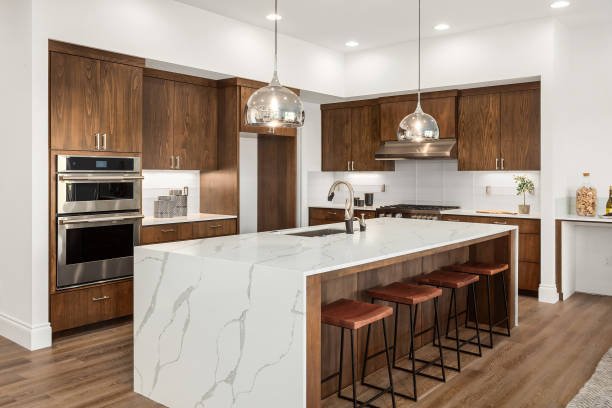
Kitchen Size and Layout
The dimensions of your kitchen and its design will go a long way toward determining what kind of island you have. Large kitchens can contain large-sized islands if the kitchen space is vast, while small kitchens require comparatively small or wheeling islands. When designing a kitchen, plan your kitchen layout properly and create enough working space around the island.
Budget Considerations
Kitchen islands’ prices vary greatly due to differences in material, size, and additional features. When planning to embark on your project, you must state exactly how much you are willing to spend. You should also consider extra costs, such as those related to electrical and plumbing if you hope to incorporate appliances or outlets.
Choosing the Right Materials
When choosing materials for your kitchen island, it is important that the material you select is in harmony with the kitchen style and that it is strong. The Department prefers granite or quartz for the countertops, whereas the base can be wood, stainless steel, or painted.
Electrical and Plumbing Requirements
If your kitchen island intends to accommodate appliances such as a cooktop or sink, you will require connections for electrical and plumbing. This can increase the cost and difficulty of installation, so always seek advice from a professional if you have any questions.
5. Kitchen Island Design Styles
Traditional Style
A traditional kitchen island may include carving, wooden cooking, and storage equipment with marble working surfaces. This style is usually used alongside modern or country house kitchens, as it gives the locality a sophisticated look.
Modern and Contemporary
Modern kitchen islands’ best feature is their simplicity of design, although many designs are general for all kitchen islands. They are replaceable with stainless steel or quartz, and these island designs provide advanced amenities such as charging slot zones or induction cooking zones.
Rustic or Farmhouse Look
Earthy kitchen islands can be old and worn with exposed wood, the popularity of shelves and a simple design with no ornamentation. The main advantage of the chosen stylistic direction is that the kitchen appears warm and friendly.
6. Common Mistakes to Avoid

Ignoring Kitchen Workflow
Perhaps one of the biggest errors that homeowners commit is overseeing the kitchen’s traffic pattern every time they decide to install an island. Remember to apply the kitchen work triangle, a configuration of the distance between the kitchen, sink, and refrigerator.
Overcrowding the Space
There is nothing wrong with trying to fit the largest island you can into a kitchen, but this only serves to ‘overpower’ the space. Ensure that people can comfortably navigate the space around the island, which should ideally be at least 36 to 48 inches wide.
Neglecting Proper Lighting
Kitchen islands often serve as multi-functional spaces for cooking, dining, and working, so proper lighting is essential. Be sure to install task lighting directly above the island, like pendant lights or recessed fixtures.
7. DIY or Hire a Professional?
Benefits of DIY Installation
A DIY kitchen island installation can be done for those purposes, suitable for handy people who love to fix things in the home. You will have low labour costs and be able to design it to suit your needs.
When to Hire a Contractor
However, if your island requires wiring or some plumbing work, hiring a professional is better. One of the main benefits of hiring a contractor is that you can be assured the installation process is done in compliance with safety codes and laws.
8. Expert Tips for Maximizing Functionality
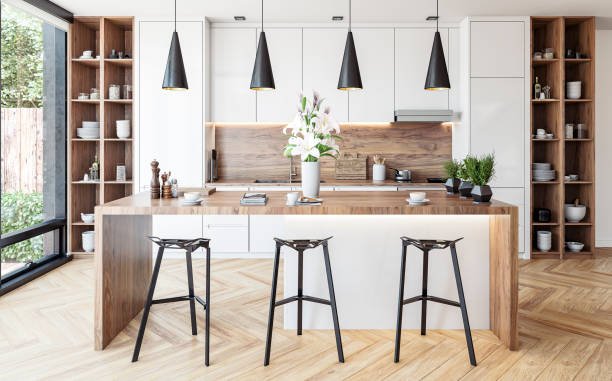
Incorporating Seating
Adding seating to your kitchen island can transform it into a casual dining area. Consider installing a breakfast bar or counter-height stools to create a versatile space for meals and socializing.
Adding Built-in Appliances
Consider integrating built-in appliances like a wine cooler, microwave, or dishwasher to maximise your island’s functionality. This makes it easy to access everything you need without leaving the island.
Optimize Storage Solutions
Don’t waste the space beneath your island. Install drawers, shelves, or even pull-out spice racks to maximize the storage potential. This will keep your kitchen organized and clutter-free.
9. The Future of Kitchen Islands
Sustainable Materials and Designs
Given that ‘green’ is increasingly a part of the thought process when designing homes, you can look forward to kitchen islands crafted out of recycled lumber or reclaimed stone. These materials not only eliminate environmental problems but also make your kitchen have a special character.
Smart Kitchen Technology
With newer inventions arriving in the smart home format, the kitchen island is changing in its design form and features. However, now we can think of smart screens charging devices’ faces, or even voice-based controls for our appliances.
Multi-functional Furniture
This may also be the time that kitchen islands become even more of an amalgamation of various furniture uses. Consider the side tables that fold and dining tables that are flipped out from an island, creating even further utility.
10. Conclusion
Therefore, adding a kitchen island is a lifesaver when it comes to home improvement. It provides more use, organises your kitchen, and is used for social interaction among families and guests. So, when deciding on the size and location of your kitchen island, you need to consider other elements, such as the size and style of the kitchen and whether you want a simple or functional kitchen island. Therefore, whether you’re aiming for an early American appearance or a contemporary one, dedicate time to planning it, and your island will be the focal point of your kitchen for several years.
FAQs
[saswp_tiny_multiple_faq headline-0=”h3″ question-0=”What are the benefits of installing a kitchen island?” answer-0=”Installing a kitchen island adds extra counter space, enhances storage options, improves kitchen functionality, and serves as a social hub where family and guests can gather.” image-0=”” headline-1=”h3″ question-1=”What types of kitchen islands are available?” answer-1=”Kitchen islands come in stationary and mobile designs. Stationary islands are fixed in place, often with electrical outlets, while mobile islands can be moved around for flexibility. They can also be open or closed in design, offering different storage options.” image-1=”” headline-2=”h3″ question-2=”What materials are best for a kitchen island?” answer-2=”Popular materials for kitchen islands include granite, quartz, and butcher block for countertops. For the base, wood, stainless steel, or painted finishes are commonly used based on durability and design preferences.” image-2=”” headline-3=”h3″ question-3=”How do I choose the right size for a kitchen island?” answer-3=”The size of the kitchen island should match your kitchen’s layout. Measure the space to ensure there’s enough clearance (36-48 inches) around the island for easy movement, especially in smaller kitchens.” image-3=”” headline-4=”h3″ question-4=”Do I need professional help to install a kitchen island?” answer-4=”For simple installations, DIY might work, but if your island requires electrical or plumbing hookups, it’s best to hire a professional to ensure safety and proper installation. ” image-4=”” count=”5″ html=”true”]


